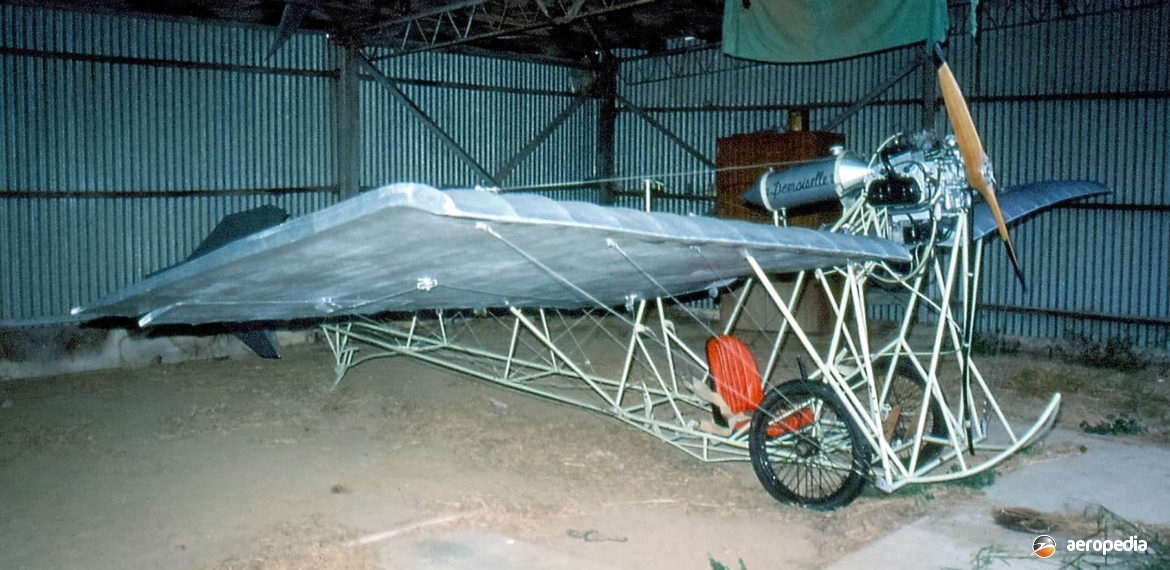Photograph:
Santos-Dumont Demoiselle replica at Mangalore, VIC in April 1984 (David C Eyre)
Country of origin:
France
Description:
Single-seat light sport monoplane
Power Plant:
One 22 kw (30 hp) Darracq two-cylinder liquid-cooled engine; or
One 19 kw (25 hp) JAP two-cylinder air-cooled engine
Specifications:
- Wingspan: 5.48 m (18 ft)
- Length: 6.09 m (20 ft)
- Height: 1.6 m (5 ft 3 in)
- Supporting surface area, including tail: 12.72 m² (137 sq ft)
- Speed with 22 kw (30 hp) engine 80 to: 96 km/h (50 to 60 mph)
- Range: 3.21 km (2 miles)
- Empty weight without engine: 60 kg (132 lb)
History:
Alberto Santos-Dumont (1873-1932) was a wealthy Brazilian living in Paris, France. He played an important part in promoting the design and construction of airships for some years from 1898, and was one of the first ‘Aeronauts’ to build and fly an airship in controlled and sustained flight. He made his first flight on 23 October 1906, and for this he became famous throughout Europe.
Santo-Dumont turned his attention to heavier than air flight in 1906 and constructed an aircraft, the 14bis, which combined features of the Wright aircraft and the boxkite developed by Australian, Lawrence Hargrave. With an 18 kw (24 hp) Antoinette eight-cylinder engine it was found to be underpowered and a 37 kw (50 hp) Antoinette engine was installed, some short hops being made.
The Demoiselle has been regarded by many as the worlds first home-built aircraft. It was the culmination of a couple of Santos-Dumont’s designs, but was more robust than the earlier designs. The type appeared in several forms from 1907, being a single-seat high-wing monoplane with a tractor engine (usually the Darracq) mounted in the leading-edge of the wing driving a two-blade 2.03 m (6 ft 8 in) diameter wooden propeller through a direct drive. Control was by a right-hand lever (for elevation), a hand-wheel (for steering), and a lever operated by the pilot’s back. To turn, the pilot warped the wings by leaning his body in the direction he wished to travel, the body movement operating the wing warping lever attached to his back. The framework was of bamboo, the two wings, each 2.7 m x 1.95 m (9 ft x 6 ft 5 in), being fabric covered. Any type of engine could be fitted, but usually the Darracq or the JAP were chosen. The Demoiselle was considered quite safe and a number were built throughout the world.
The first Demoiselle, known as Number 19, had a two-cylinder 13 kw (18 hp) liquid-cooled Dutheil-Chalmers engine. It was overweight and underpowered but managed flights of up to 200 m (656 ft). Santos-Dumont moved on to the 19bis, which was improved structurally, having the same cruciform tail supported by three bamboo booms, and was fitted with an 18 kw (24 hp) liquid-cooled engine. This became his first successful aircraft, and was named Demoiselle [French for both dragonfly and young lady]. It first flew on 6 March 1909. It had a wingspan of 5.48 m (18 ft), a wing area of 9.94 m² (107 sq ft) and a weight of 244 kg (538 lb).
The design became very popular and Santos-Dumont allowed others to freely use his design, having no desire to make money from his inventions. He encouraged the Clement-Bayard Motor Company to manufacture and market the design. Many were built, being sold for $US1,500, and it became famous for its air-show performances. The 1913 version had a 37 kw (50 hp) Gnome engine. The US Naval Aircraft Factory built two in 1918, these being known as the SA-1, which could take off from platforms on battleship gun turrets. The first German-built aeroplane in 1910, known as the Grade, is said to owe much to the Demoiselle.
Many replicas have been built over the years for movie work, including an example appearing in the movie “Those Magnificent Men in their Flying Machines”, this example being one of five 1910 period aeroplanes constructed for the film’s international air race from London to Paris, the Demoiselle initially having a modified 22 kw (30 hp) Volkswagen engine, but this was replaced by a 37 kw (50 hp) unit.
This machine was imported to Australia in the mid 1960s, being carried as cargo on the delivery flight of one of the Ansett-ANA ATL Carvairs. It was displayed at a number of shopping centres during 1965 and 1966. It was flown at Bankstown, NSW on a couple of occasions and at least once in Melbourne, VIC when an Ansett-ANA pilot, R Weatherstone, flew it on 15 December 1965. Thereafter it was obtained by Ansett Airlines and used for public relations purposes for a number of years. In 1978 it was loaned to the RAAF Association in Perth, WA eventually finding its way into the Bull Creek Museum. In 1984 it was returned to Ansett and was noted hangared at Mangalore, VIC. In 1985 it was placed on display at the Eureka Museum at Ballarat, VIC.
Another replica has been built and is on display at the RAAF Association Museum in Perth, WA. This machine was a copy of the one above and was built by Frank Matthews for the museum. It was built from timber and was fitted with a 1920 model 22 kw (30 hp) two-cylinder Aeronca engine. It was first displayed at the Beverley Air Show in November 1984. Mr Matthews later went on to build a replica of a Sopwith Camel (M6394) for the museum, fitting it with a Le Rhone rotary engine.
In Queensland TAVAS (The Australian Vintage Aviation Society) has had a replica built and it has been placed on display at the organisation’s museum at Caboolture.

